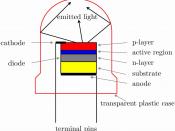I.Introduction: The voltage drop (V) across and electrical component of resistance (R) that has a current (I) through it is given by V = I R. By varying the current through a resistor, one can measure the changes in the voltage drop across the resistor. Once the data is acquired, a graph in a linear plot will be the best to interpret the given information.
II.Materials: Six AAA batteries, multimeter, and aelectrical kitIII.Procedure: 1) Wire the circuit with the giveninstructions from the manual.
2) Receive assurance from the instructor that thecorrect assembly is used.
3) Turn on the multimeter (start at lowestsensitivity).
4) Increase the voltage and measure data5) Create a data table, diagram, and/or graphthat displays the resistance.
IV.Results:Voltage: 9 voltsResistance: 18 ohmsCurrent: 0.5 amperesV.Anlaysis and Conclusion: V/R= I R/R I = V/RI = 9 volts/ 18 ohmsI = 0.5 amperesOne ohm is the resistance value through which onevolt will maintain a current of one ampere.
Resistors are used to control voltage and currentlevels. A very high resistance allows a smallamount of current to flow. A very low resistanceallows a large amount of current to flow.
VI.Extension and Application: Everyday one can see the application of ohmÃÂs law. One in particular that is seen more often as when on a way home is a light-emitting diode (LED). Because of their extreme durability, they have become the choice in high-reliability applications which can be seen in traffic lights, emergency exit signs, and brake lights.


